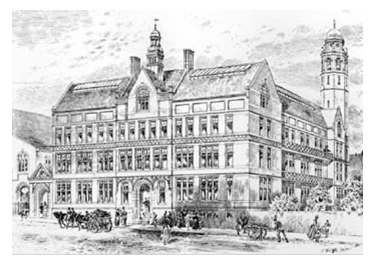NORTHUMBRIA UNIVERSITY

HISTORY OF NORTHUMBRIA UNIVERSITY
Northumbria's international reputation as a leading British university is the result of a distinctive combination of outstanding academic research and teaching, innovative programmes, traditional values and social and cultural diversity. Since its foundation in the historic City of Newcastle upon Tyne, the University has developed into a successful regional, national and international institution.
History

Originally known as Newcastle Polytechnic, the University was formed in 1969 from the amalgamation of three regional colleges: Rutherford College of Technology, the College of Art & Industrial Design, and the Municipal College of Commerce. These colleges themselves had origins which were deeply rooted in the region. The practical and vocational training needs of local industry had stimulated the development of relevant post-school education as far back as the nineteenth century.
Building on these firm foundations, the Polytechnic became one of the leading institutions of its type in the UK. It became a major centre for the initial training of teachers with the incorporation of the City College of Education in 1974, and subsequently the Northern Counties College of Education in 1976.
In 1976 the Polytechnic, which already offered nurse training, began occupational therapy and physiotherapy training. September 1992 marked the inauguration of the University when the Polytechnic was awarded university status and became Northumbria University. In 1995 the incorporation of the Bede, Newcastle and Northumbria College of Health Studies was transferred into the University.
A book providing a detailed account of the history of Northumbria University has been published by Northumbria University Press. Rutherford's Ladder: the Making of Northumbria University, 1871-1996 charts the early history of Northumbria University and the academic institutions from which it was created.
Largest Regional University
By the year 2000 Northumbria University was the largest university in the North East of England, with a broad portfolio of courses and a rich cultural diversity in its student population. Northumbria has a student population of around 32,000 with 3,300 overseas students on our Newcastle campuses and a further 3,000 studying on University programmes in their own countries. Growth in recent years has been both impressive and carefully managed as part of the University's overall strategic development and in the context of a careful review of our academic portfolio. Courses have been examined for their relevance and value to society and we are now offering programmes in all of the UK's 30 most popular subjects. Northumbria is the leading provider of high-calibre graduates to business, industry and the professions in the North East of England and one of the highest nationally.
Academic Profile
Teaching and research activities are managed by four faculties: Arts, Design and Social Sciences; Engineering and Environment; Business and Law; and Health and Life Sciences.
The highest standards have been maintained, with an excellent result in a recent Institutional Audit by the Quality Assurance Agency. The professional standing of our programmes has been endorsed with accreditation from over 30 professional bodies. Northumbria's success in learning and teaching is underpinned by a range of professional services, with award-winning support from the library, and a world class IT infrastructure providing wireless coverage throughout.
Research and Enterprise
Research and enterprise activities are a major priority and the University today enjoys a significant number of commercial and professional collaborations and partnerships. Northumbria University is constantly developing corporate learning partnerships and levels of consultancy and training has seen a sustained increase in recent years.
The Estate
Since the start of this century, the University has consolidated its presence on two major campuses in Newcastle upon Tyne - one in the city centre and the other in a suburban location on the edge of the city, at Coach Lane. Clear academic success and financial growth has enabled the University to make significant investment in its estate, extending the City Campus on to a new site with two magnificent new buildings. The University is one of North East England's major employers. There is ongoing refurbishment of existing teaching facilities, walkways and shared spaces. The two city centre sites have been unified into one integrated campus with the building of an iconic footbridge across Newcastle's central motorway.
Other developments included the landscaping and pedestrianizing of the City Campus, improvements to the academic accommodation and the building of a new £31m sports centre for the benefit of staff, students and members of the public. This outstanding facility, Sport Central, opened in September 2010.
These extensive developments are integral to Northumbria's ambition to be one of the world's leading universities, renowned for the excellence of its research and teaching, the high quality of its student experience, its innovative research and professionally based practice and and entrepreneurial flair which transforms the economic, cultural and social life of the communities it serves.
Our Vision
Northumbria University is a research-rich, business-focused, professional university with a global reputation for academic excellence.
Our ambition is to be in the top 30 of UK universities. Northumbria is transforming to become a new kind of excellent university. To achieve this transformation, between 2013 and 2018 we will:
- • Build global reputation, market position and revenue streams
- • Grow high quality research and use it to drive excellence in all of our activities
- • Maximise student and stakeholder satisfaction
- • Strengthen operational efficiency and effectiveness, and foster a culture of continuous improvement.

